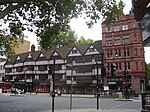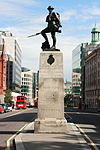Bourne Estate

The Bourne Estate is an Edwardian housing estate in the Holborn district of Central London. It is bounded by Clerkenwell Road to the north, Gray's Inn Road to the west, Leather Lane to the east and Baldwins Gardens to the south. It is also intersected by Portpool Lane, which forms part of the estate itself. The estate is built in a free Classical style, with Arts and Crafts touches, developing the idiom established by the London County Council with the Boundary Estate and Millbank Estate in a formal direction.The estate consists of a number of residential blocks which enclose a number of quiet shady courtyards containing mature trees, mostly London Plane trees. The buildings are constructed in dusky red and yellow bricks and the design incorporates classical pediments and stucco pilasters as well as arts and crafts details such as gabled walls, and casement windows on the inner courtyards and decorative mouldings to the large arches on the access ways.In 2013 planning permission was granted for a £14 million regeneration of the Bourne Estate. Matthew Lloyd Architects’ scheme, developed with Camden Council and Tibbalds Planning and Urban Design, provides 75 new homes across two mixed tenure blocks. Landscaping is to be improved across the southern half of the estate with re-ordered public realm, sports and playspaces by Dally Henderson Landscape Architects.
Excerpt from the Wikipedia article Bourne Estate (License: CC BY-SA 3.0, Authors, Images).Bourne Estate
Verulam Street, London Holborn (London Borough of Camden)
Geographical coordinates (GPS) Address Nearby Places Show on map
Geographical coordinates (GPS)
| Latitude | Longitude |
|---|---|
| N 51.520833333333 ° | E -0.11138888888889 ° |
Address
Dobson Court
Verulam Street
WC1X 8LZ London, Holborn (London Borough of Camden, Bourne Estate)
England, United Kingdom
Open on Google Maps









